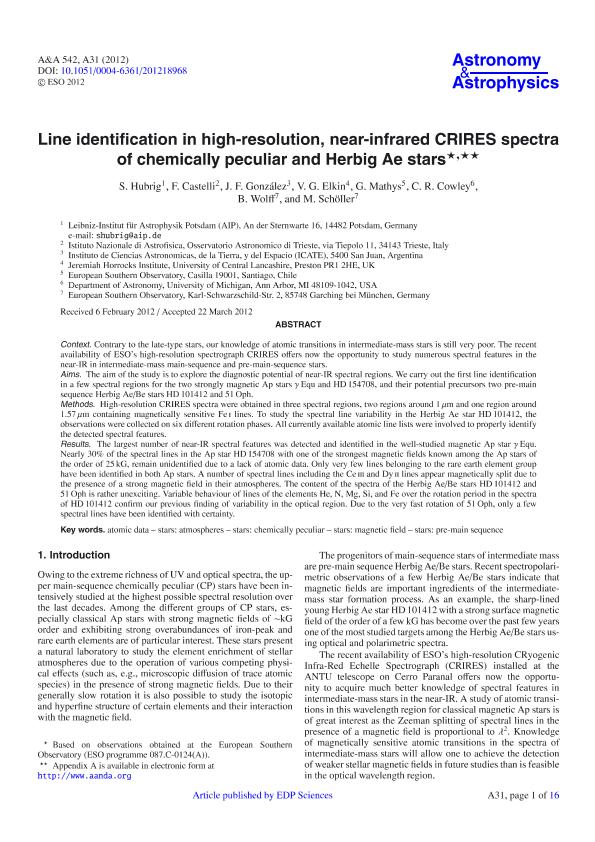Mostrar el registro sencillo del ítem
dc.contributor.author
Hubrig, S.
dc.contributor.author
Castelli, F.
dc.contributor.author
Gonzalez, Jorge Federico

dc.contributor.author
Elkin, V. G.
dc.contributor.author
Mathys, G.
dc.contributor.author
Cowley, C. R.
dc.contributor.author
Wolff, B.
dc.contributor.author
Schöller, M.
dc.date.available
2019-01-31T18:28:56Z
dc.date.issued
2012-06
dc.identifier.citation
Hubrig, S.; Castelli, F.; Gonzalez, Jorge Federico; Elkin, V. G.; Mathys, G.; et al.; Line identification in high-resolution, near-infrared CRIRES spectra of chemically peculiar and Herbig Ae stars; EDP Sciences; Astronomy and Astrophysics; 542; 6-2012; 1-16; A31
dc.identifier.issn
0004-6361
dc.identifier.uri
http://hdl.handle.net/11336/69125
dc.description.abstract
Context. Contrary to the late-type stars, our knowledge of atomic transitions in intermediate-mass stars is still very poor. The recent availability of ESO's high-resolution spectrograph CRIRES offers now the opportunity to study numerous spectral features in the near-IR in intermediate-mass main-sequence and pre-main-sequence stars. Aims. The aim of the study is to explore the diagnostic potential of near-IR spectral regions. We carry out the first line identification in a few spectral regions for the two strongly magnetic Ap stars γ Equ and HD 154708, and their potential precursors two pre-main sequence Herbig Ae/Be stars HD 101412 and 51 Oph. Methods. High-resolution CRIRES spectra were obtained in three spectral regions, two regions around 1 μm and one region around 1.57 μm containing magnetically sensitive Fe i lines. To study the spectral line variability in the Herbig Ae star HD 101412, the observations were collected on six different rotation phases. All currently available atomic line lists were involved to properly identify the detected spectral features. Results. The largest number of near-IR spectral features was detected and identified in the well-studied magnetic Ap star γ Equ. Nearly 30% of the spectral lines in the Ap star HD 154708 with one of the strongest magnetic fields known among the Ap stars of the order of 25 kG, remain unidentified due to a lack of atomic data. Only very few lines belonging to the rare earth element group have been identified in both Ap stars. A number of spectral lines including the Ce iii and Dy ii lines appear magnetically split due to the presence of a strong magnetic field in their atmospheres. The content of the spectra of the Herbig Ae/Be stars HD 101412 and 51 Oph is rather unexciting. Variable behaviour of lines of the elements He, N, Mg, Si, and Fe over the rotation period in the spectra of HD 101412 confirm our previous finding of variability in the optical region. Due to the very fast rotation of 51 Oph, only a few spectral lines have been identified with certainty.
dc.format
application/pdf
dc.language.iso
eng
dc.publisher
EDP Sciences

dc.rights
info:eu-repo/semantics/openAccess
dc.rights.uri
https://creativecommons.org/licenses/by-nc-sa/2.5/ar/
dc.subject
Atomic Data
dc.subject
Stars: Atmospheres
dc.subject
Stars: Chemically Peculiar
dc.subject
Stars: Magnetic Field
dc.subject
Stars: Pre-Main Sequence
dc.subject.classification
Astronomía

dc.subject.classification
Ciencias Físicas

dc.subject.classification
CIENCIAS NATURALES Y EXACTAS

dc.title
Line identification in high-resolution, near-infrared CRIRES spectra of chemically peculiar and Herbig Ae stars
dc.type
info:eu-repo/semantics/article
dc.type
info:ar-repo/semantics/artículo
dc.type
info:eu-repo/semantics/publishedVersion
dc.date.updated
2019-01-31T14:02:38Z
dc.journal.volume
542
dc.journal.pagination
1-16; A31
dc.journal.pais
Francia

dc.journal.ciudad
Paris
dc.description.fil
Fil: Hubrig, S.. Leibniz Institut für Astrophysik Potsdam; Alemania
dc.description.fil
Fil: Castelli, F.. Istituto Nazionale di Astrofisica; Italia
dc.description.fil
Fil: Gonzalez, Jorge Federico. Consejo Nacional de Investigaciones Científicas y Técnicas. Centro Científico Tecnológico Conicet - San Juan. Instituto de Ciencias Astronómicas, de la Tierra y del Espacio. Universidad Nacional de San Juan. Instituto de Ciencias Astronómicas, de la Tierra y del Espacio; Argentina
dc.description.fil
Fil: Elkin, V. G.. University of Central Lancashire; Reino Unido
dc.description.fil
Fil: Mathys, G.. European Southern Observatory; Chile
dc.description.fil
Fil: Cowley, C. R.. University of Michigan; Estados Unidos
dc.description.fil
Fil: Wolff, B.. European Southern Observatory; Alemania
dc.description.fil
Fil: Schöller, M.. European Southern Observatory; Alemania
dc.journal.title
Astronomy and Astrophysics

dc.relation.alternativeid
info:eu-repo/semantics/altIdentifier/doi/http://dx.doi.org/10.1051/0004-6361/201218968
dc.relation.alternativeid
info:eu-repo/semantics/altIdentifier/url/https://www.aanda.org/articles/aa/abs/2012/06/aa18968-12/aa18968-12.html
Archivos asociados
